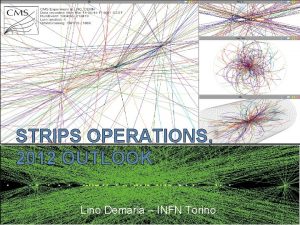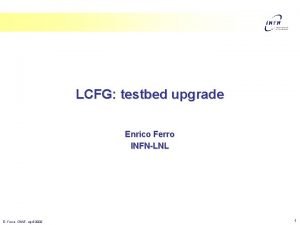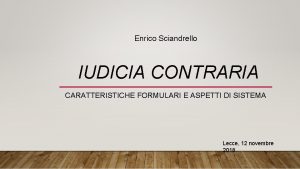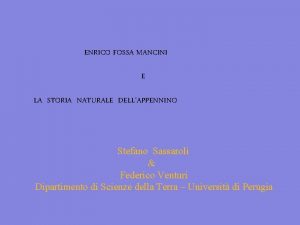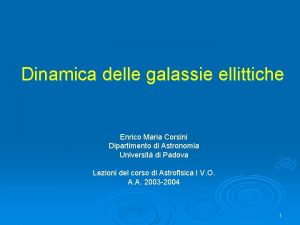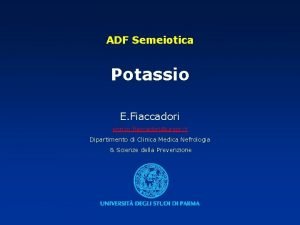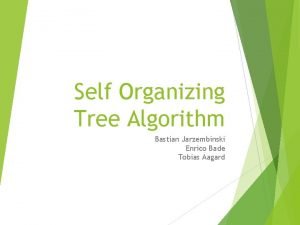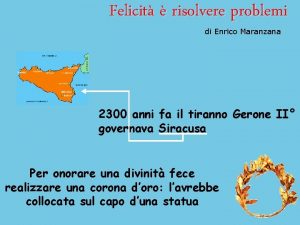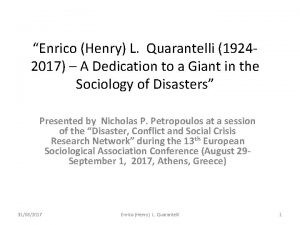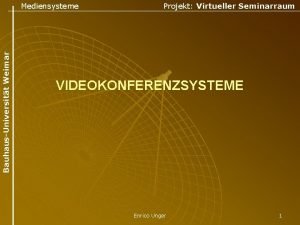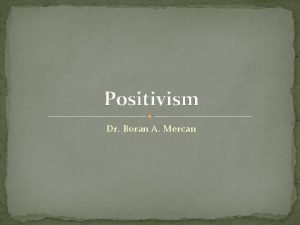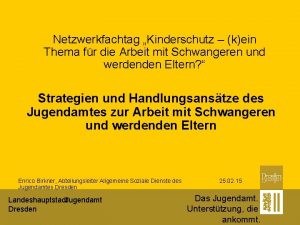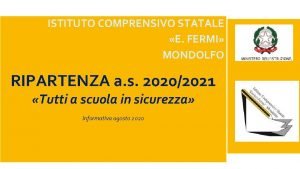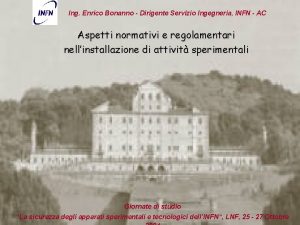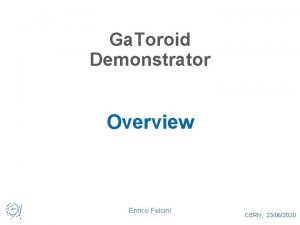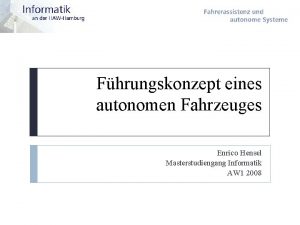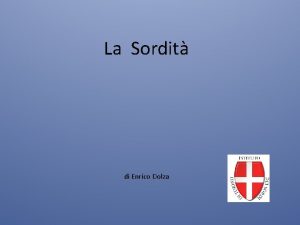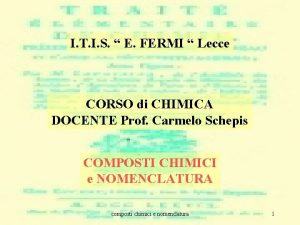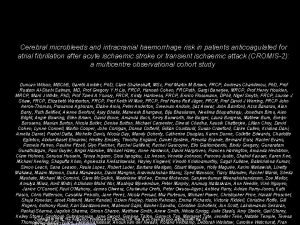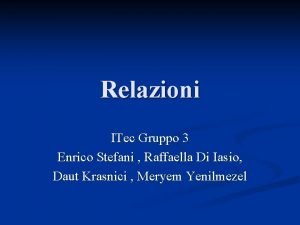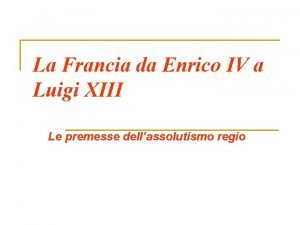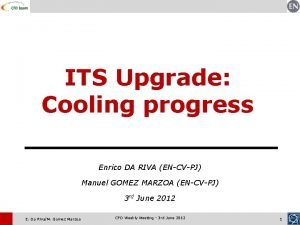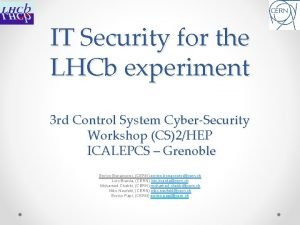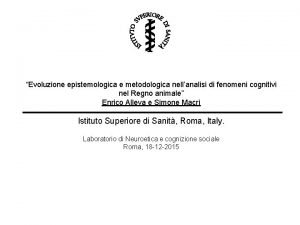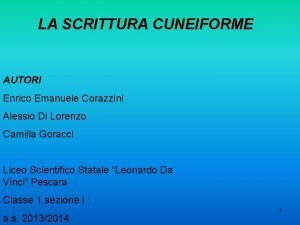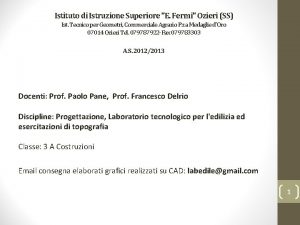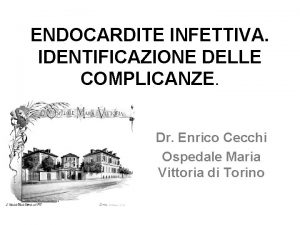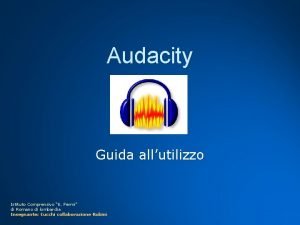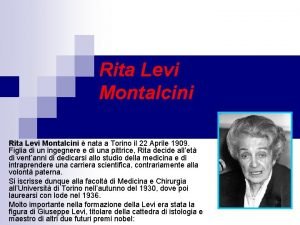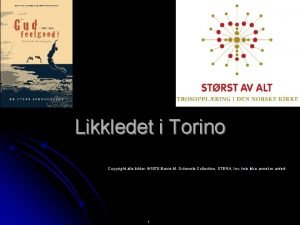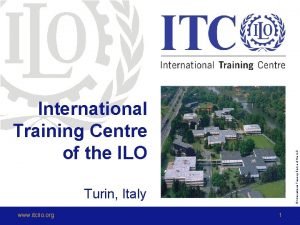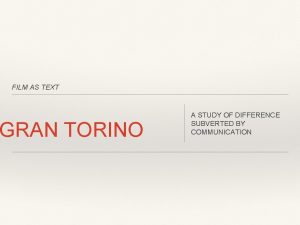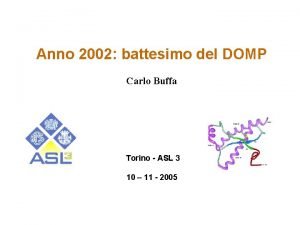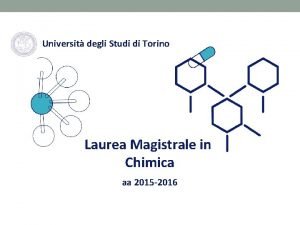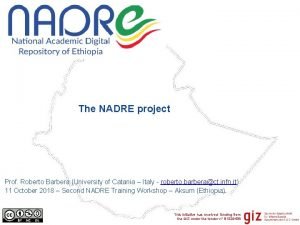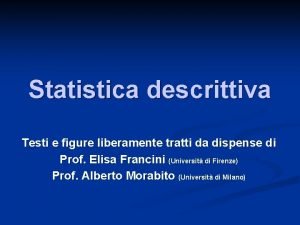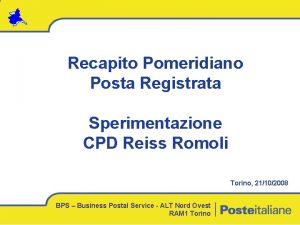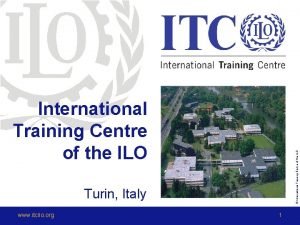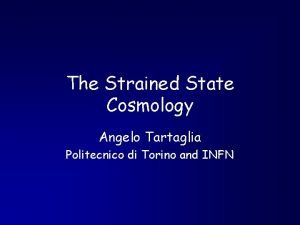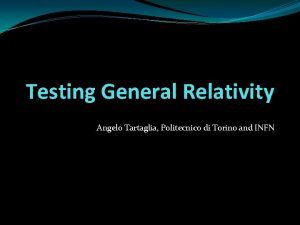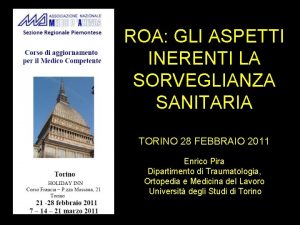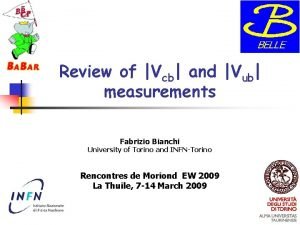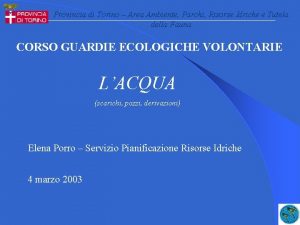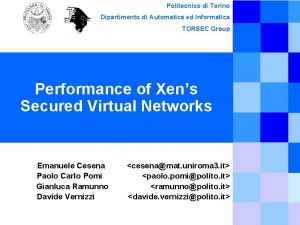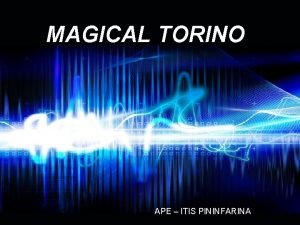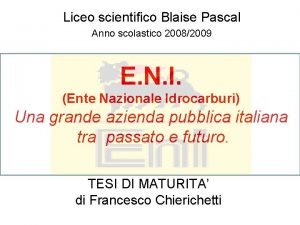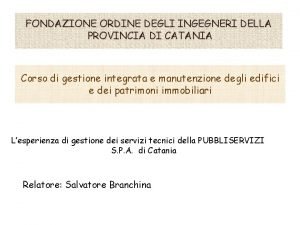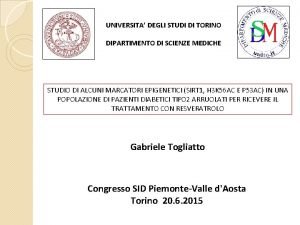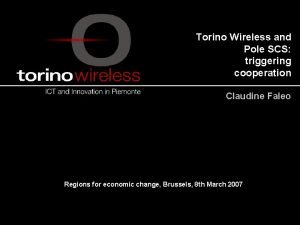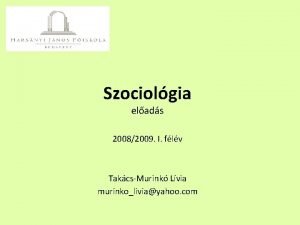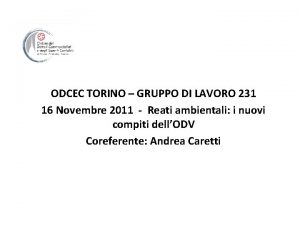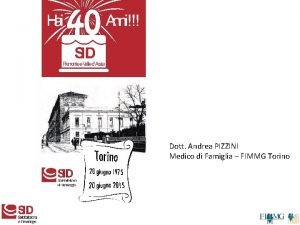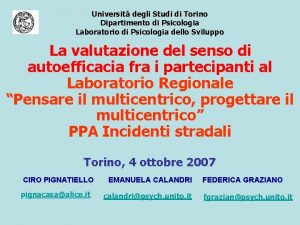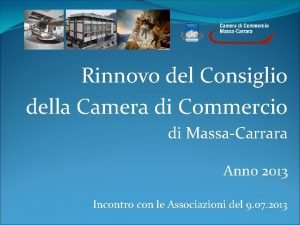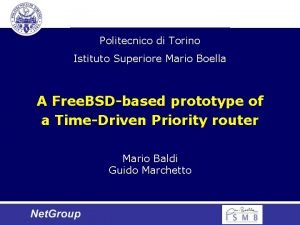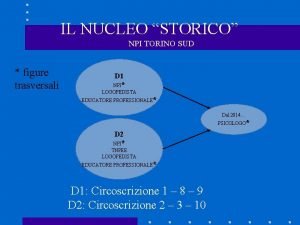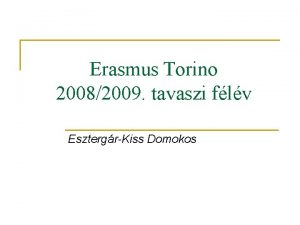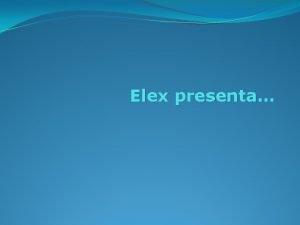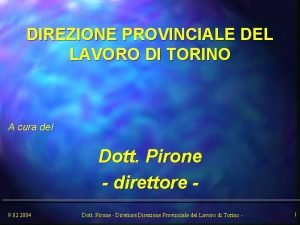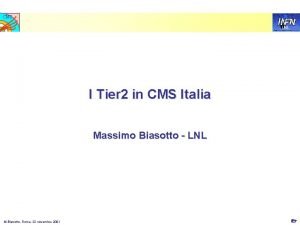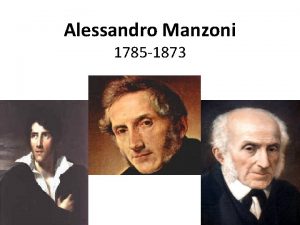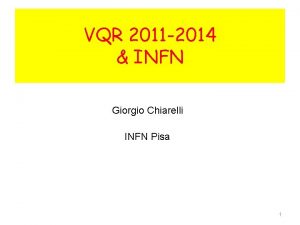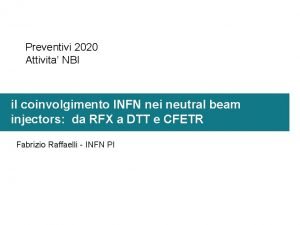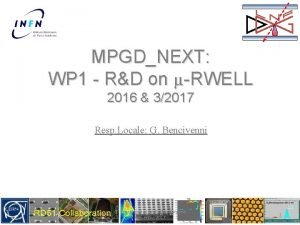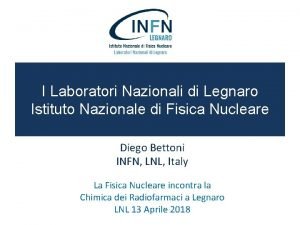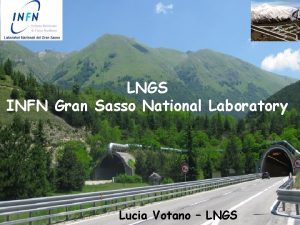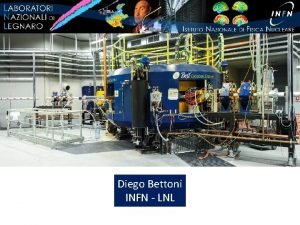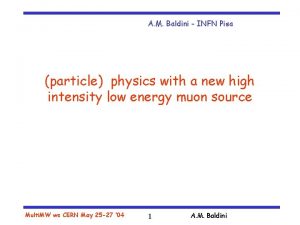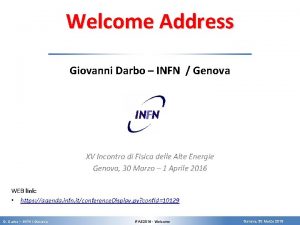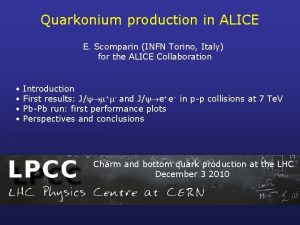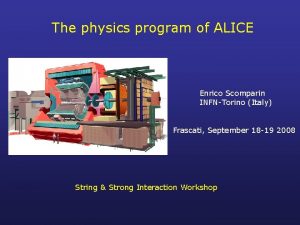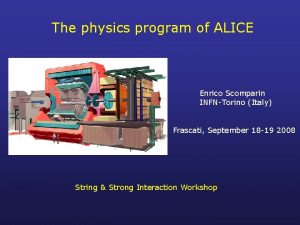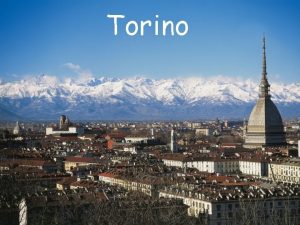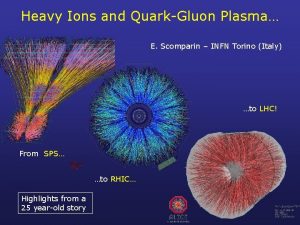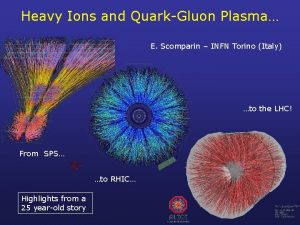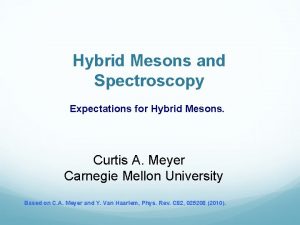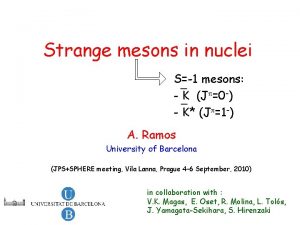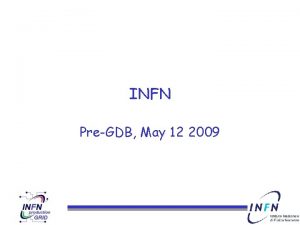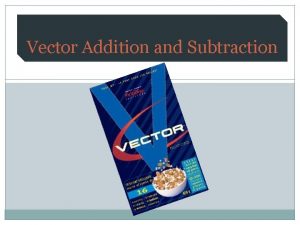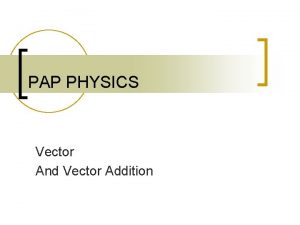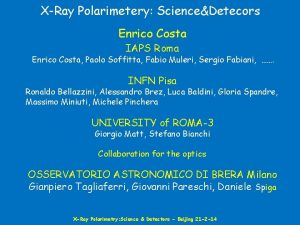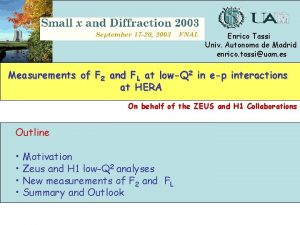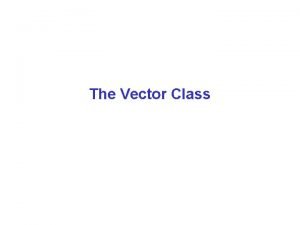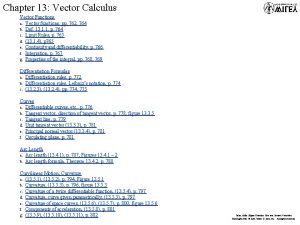Dileptons and vector mesons Enrico Scomparin INFN Torino










































































































- Slides: 106

Dileptons and vector mesons Enrico Scomparin INFN Torino (Italy). . . a rich past. . . a lively present. . . a promising future. . .

(Possible) program • Why do we study dileptons ? Which are the questions ? • Study signals related to deconfinement • Low mass dileptons • Intermediate mass dileptons • High mass dileptons Lecture 1 • How do we study dileptons ? Muons and electrons • Various experimentalist’s issues • Luminosity • Resolution • Acceptance • Backgrounds • What have we learned until now ? Answers • SPS, from 1986 • RHIC, from 2000 • What is still missing ? Perspectives • LHC, from 200~7 • Future of SPS and RHIC physics Lecture 2

Dileptons: a very promising physics…. . • Search for the transition from nuclear matter to a deconfined state of quarks and gluons (QGP), predicted by QCD at high enough temperature and density • Favourable environment: heavy-ion collisions (T, µB) • Questions: • Can deconfinement be reached ? At SPS energy ? At RHIC ? • In which conditions ? System size, incident energy, centrality…. . • Dileptons are an ideal tool for QGP studies • They are a probe of the deconfined phase since they are not subject to strong interaction, and therefore are not significantly affected by the medium at later stages of the collision • Experiment measuring dileptons can access hard probes, such as heavy quark and quarkonia that, being created early by hard parton scatterings, can be affected in a predictable way by the “hot”, deconfined medium

. . . but there are problems too Lots of physics processes contribute to the dilepton mass spectrum Modifications dueof tolepton QCD pairs phase transition known sources 2 consequences thermal radiation • The physics content is very rich, but it is not easy to disentangle trivial and “interesting” sources (especially in the continuum) • Even for interesting sources we measure an integral yield over the various stages of the collision: which dileptons do come from the deconfined phase ? Chiral symmetry restoration continuum enhancement modification of vector mesons suppression (enhancement)

The high mass region: heavy quarkonia studies • It was not in the wish list at the very beginning of the field • No experiment was explicitly designed for charmonia detection • Even NA 38 (proposed in March 1985) was aiming at the study of thermal dimuon production • Then, came Matsui and Satz prediction:

Charmonium production (and suppression) • Ideally, J/ yield is characterized by: • hard production: • suppression by colour screening in the QGP Hierarchy of suppression Binding energy: J/ 650 Me. V c 250 Me. V ’ 50 Me. V Td/Tc = 1. 10 Td/Tc = 0. 74 Td/Tc = 0. 1 - 0. 2 • However, the situation is more complicate since resonances can be suppressed by different sources • Ordinary absorption processes, i. e. normal J/ suppression • Nuclear absorption, path of the cc state in nuclear matter • Dissociation by a hadron gas, possible in A-B collisions, not possible in p-A • Debye colour screening, i. e. anomalous J/ suppression • Present only in heavy ion collisions

Charmonium: setting a reference • How can we say that we have observed a suppression of the J/ ? • We need an unsuppressed reference (to set a baseline) J/ production in pp collisions • But we also need a way to understand if the suppression that we (possibly) observe in nucleus-nucleus collisions is due to trivial sources or not • We need a large systematics from p-p to p-A to A-A collisions (with various projectile-target combinations), collected in the same kinematical domain • A suppression effect already visible in p-A and then smoothly increasing in A-A is hardly due to a genuine deconfinement effect • It is also important to have an unsuppressed reference process (different from J/ production) that can be used for an easier normalization of the J/ yield open charm, Drell-Yan

What happens if the reference is not well chosen ? • When the reference is not accurate, conclusions are often biased • Take first results from NA 38 J/ suppression in O-U collisions NJ/ Cont. (2. 7 -3. 5) Fit to the continuum was done for mµµ >1. 7 Ge. V J/ is suppressed by a factor 2 ! • Nuclear absorption was not accurately known • Seemed to be not enough to explain the data! • QGP ? • Hadronic comovers ? NA 38, Phys. Lett. B 220(1989) 471 Both conclusions were wrong !

What can we learn from the quarkonia suppression pattern ? (2 S) (3 S) c(1 P) (2 S) J/ b(2 P) b(1 P) (1 S) Digal et al. , Phys. Rev. D 64(2001)094015 • Powerful tool to extract the temperature of the medium because of the different melting temperature for the various resonances • Some resonances need a deconfined medium to be broken, others melt for T<Tc • But before drawing physics conclusion we must set an accurate reference for the various states decay feed-down needs to be understood/measured

Heavy quarkonia: end of introduction • An effect directly connected to the change of properties of the medium expected at deconfinement • Not so clear for other hard processes: jet quenching effects smoothly increase with energy density, not so directly linked to the nature of the medium • The experiments must provide: • Careful evaluation of the reference process • Accurate determination of the various feed-down • Caveat: at high incident energy (RHIC, LHC) regeneration processes, due to the high heavy quark multiplicity, might substantially complicate the picture

The intermediate mass region: thermal dileptons, open charm. . • Region in between the and the J/ : probably the most difficult from the experimentalist’s point of view • Known sources • Lepton pairs from correlated (SPS) and uncorrelated (RHIC, LHC) open charm decays • Drell-Yan dileptons • New sources (expected only in A-A collisions) • Thermal dileptons • Problem • The various sources have similar mass distributions • Their centrality dependences are also similar

“The” problem: the background subtraction • Combinatorial and K decays dominate the mass spectrum in the IMR The “interesting” signal sits on top of this background that needs to be subtracted • Typical signal/background ~5% for Pb-Pb collisions • While for high mass dileptons usually the errors are essentially statistics (high luminosity is needed to collect a significant statistics), for the IMR we are dominated by systematics

Disentangling the signal sources in the IMR • The dileptons from charm decay can be identified by tagging their production point with respect to the primary interaction vertex • Identify the typical offset of D-meson decay (~100 µm) D 0 • Need a very good vertexing accuracy (~20 -30 µm, in the transverse plane) • Obtained at SPS by NA 60 100 m D 0 • Expected for the PHENIX update and in ALICE (electrons) Ke+ • Distinguish thermal, prompt component from heavy quark decay component e

Physics to be learned in the IMR • Open charm (bottom) production • Interesting as: • Normalization for charmonia (bottomonia) study • Share the same initial state • Ideal reference (not the case for Drell-Yan, commonly used for the J/ yield normalization) • Per se • Do heavy quarks suffer quenching as light flavors do ? • Complementary results with respect to quenching of high p. T light hadrons • Do heavy quarks flow ?

Physics to be learned in the IMR (2) • Thermal dilepton (and photon) production • Direct signature of QGP • Direct measurement of plasma temperature • But: • no really convincing signal observed in the photon sector (large background and systematics) • WA 98 sees a signal in central Pb-Pb compatible with Tin ~ 270 Me. V • PHENIX does not see a sizeable signal over p. QCD contribution • Calculations need • model for thermal production • folding over the fireball history PHENIX WA 98

Low mass dileptons: , , and the underlying continuum • Many physics topics • Strangeness enhancement in the sector • Modifications of the and of the continuum: see Ralf’s lectures • LMR exhibits a rather complicate superposition of hadronic sources (the hadronic cocktail) • Dominated by Dalitz decays of light mesons • Availability of reference p-p, p-A data is essential

Low mass dileptons: backgrounds • Again, background is a very important issue • After event selection, S/B values at CERES (mee>200 Me. V/c 2) are of the order of 1/13 • LMR is better investigated by dielectron experiments (no low m. T cut-off) • Background dominated by photon conversion ( 0 decays) • A minimum amount of matter in the set-up is needed • Recently, dimuon experiments are starting to play an important role (NA 60) • Background in dimuon experiments is mainly combinatorial ( and K decays) Needs an efficient stopping of hadrons, as close as possible to the target

How do we measure dimuons ? • Which elements should be taken into account when designing a dimuon experiment ? • Mass resolution Necessary in order to separate resonances closely packed in the spectrum • Vertexing accuracy Necessary in order to separate prompt from displaced sources • Possibility of running at high luminosity Necessary to measure rare processes (as the ones involving dileptons) • Acceptance window Crucial to address certain physics observables (e. g. low mass continuum) • Background level Fundamental for continuum analysis Let’s analyze typical dimuon set-ups

Standard way of measuring dimuons: NA 50, PHENIX, ALICE, etc muon trigger and tracking beam Iron wall magnetic field target hadron absorber Muon Other • Place a huge hadron absorber to reject hadronic background • Implement a trigger system, based on fast detectors, to select muon candidates (1 in 10 -4 interactions, in Pb-Pb collisionsat SPS energy) • Reconstruct muon tracks in a spectrometer (magnetic field + tracking detectors) • Correct for multiple scattering and energy loss • Extrapolate muon tracks back to the target • Vertex reconstruction is usually rather poor ( z~10 cm)

Consequences of a limited mass resolution • Difficult to see the ’ as a shoulder of the J/ • Impossible to separate and Christensen et al. , Phys. Rev. D 8 (73) 2016 NA 51 E 605 1 nb ? p-U at 20 -30 Ge. V 1 pb M(J/ ) = 300 Me. V M (Ge. V)

Possible solutions • Radical solution: eliminate the hadron absorber • Done by E 789 when measuring ’ production in p-Au collisions at 800 Ge. V 16 Me. V dimuon mass resolution at the J/ • Drawbacks • No dimuon continuum physics • Not healthy for the tracking chambers, overwhelmed with hadron tracks • Add a vertex detector and match the muon tracks to tracks in the target region • Done by HELIOS-1 in p-Be collisions at 450 Ge. V (the occupancies in the drift chambers were too high the high rate p-W run) • Presently being done by NA 60, with silicon tracking planes, even in the high multiplicity environment of central heavy-ion collisions, thanks to a technological breakthrough: radiation tolerant silicon pixel detectors J/ E 789 p-Au @ 800 Ge. V ’ HELIOS-1 p-Be 450 Ge. V

NA 60: a second generation experiment 2. 5 T dipole magnet vertex tracker targets Iron wall magnetic field beam tracker muon trigger and tracking hadron absorber Muon Other Matching in coordinate and momentum space • Improved dimuon mass resolution • Origin of muons can be accurately determined or !

Improvement in mass resolution NA 60 ’ before after p-nucleus at 400 Ge. V In-In @ 158 Ge. V A • From 70 to 20 Me. V at mµµ~ 1 Ge. V NA 60 • From 100 to 70 Me. V at mµµ~ 3 Ge. V

Smearing sources • Multiple scattering dominates the resolution for low momentum muons • The variance s of the angle distribution is proportional to 1/p • At high momenta the resolution is dominated by the tracking accuracy ( p/p proportional to p) • The invariant mass resolution for the muon spectrometer has two components • The one due to multiple scattering “explodes” at low mass • At mµµ ~ 1 Ge. V, track matching is a very effective way for increasing the momentum resolution • This is no more the case at mµµ ~ 3 Ge. V where multiple scattering contribution is no more important

Vertex resolution NA 60 • The selection of the target where the interaction took place requires a good z-vertex resolution (in NA 60: ~ 200 µm) Indium beam 7 In targets 158 A Ge. V Beam tracker station target box windows z-vertex (cm) • A good accuracy on the determination of the transverse coordinates of the interaction point is needed to separate the prompt dimuons from the charm decays (in NA 60: ~ 20 µm) NA 60

Problems connected with high luminosity • Principle is very simple: high beam intensities incident on thick targets • Problems • High beam intensity • Need • Fast detectors (especially the ones on the beam line, such as beam hodoscopes and ZDCs) • Radiation hard detectors • Efficient beam pile-up rejection • Thick target (> 10 -20% I) • Interaction pile-up and/or reinteraction (more difficult to detect) • May significantly bias the centrality measurement • Depending on the centrality detector a peripheral event may be seen as central (multiplicity) or a central event may be seen as peripheral (forward energy) A reasonable limit has to be chosen, to keep systematics induced by these effects at a reasonable level

Luminosity: collider versus fixed target experiments • At collider experiments, it is more difficult to reach integrated luminosities comparable with those obtained in fixed target mode • Measuring J/ and ’ production in Pb-Pb (Au-Au) collisions; NA 50 vs. PHENIX • Beam intensity 1. 4· 107 Pb/s, 5 s burst, 3 bursts/min • Typical data taking: 2 months • Np= 1. 4· 107 5 3 60 24 60 ~ 1. 8 · 1013 • Typical Pb target: 1. cm ~ 0. 06 I Nt = (NA· ·l)/A = 6 · 1023 · 11. 3 · 1/208 ~ 3. 3 · 1022 LSPS = Np Nt ~ 6 · 1035 cm-2 • RHIC nominal luminosity 2 · 1026 cm-2 s-1 • Typical data taking: 20 weeks LRHIC = 2 · 1026 86400 7 20 ~ 2. 4 · 1033 cm-2 (only partly compensated by the higher )

High luminosity and triggering High luminosity High interaction rate • If one wants to collect every interaction • Enormous amount of (useless) events • Dead time ~ 100% • Impossible to study rare processes • Need for a fast (and very selective) trigger system • NA 10/NA 38/NA 50/NA 60 (1980) fully based on NIM/CAMAC electronics • Identify two muon candidates by means of coincidences between scintillators (1 event in 106) • Fast (decision in < 500 ns) • HERA-B (2000) • Identify B 0 J/ KS (1 event in 1011) • First level trigger: network of custom-made processors interconnected by high-speed optical links Beware of trigger biases !

Acceptances • Probability that a dimuon produced with certain kinematical values (m, y, p. T, cos( )) is detected by the experiment • It’s a multidimensional function (correlations between variables) • e. g. the acceptance as a function of dimuon p. T depends on the distribution that we have assumed for the other kinematical variables • Usual (simpler) procedure • Generate events according to some theoretical model • “Filter” them through a Monte Carlo simulation program reproducing the detector limitations and the analysis selection procedures • Get the acceptance as a function of the kinematical variable i as • A(i) = Nrec (i)/ Ngen (i) (1 -D acceptance) • The method is not suitable : • If the source distribution is not very well known (e. g. thermal dimuons) • If one wants to extract from the data the distribution of a kinematical variable for a given process (because of the correlations between the various kinematical variables) • In this case • Flat generation over a multi-dimensional, fine-spaced grid • Calculate 4 -D acceptance matrices

Example: NA 60 without field A (%) • The acceptances depend on the magnetic fields (in the muon spectrometer and in the vertex telescope), on the “thickness” of the muon filter, on the relative distances between the target, the detecting elements and the magnet, etc. . 0. 9 < M < 1. 1 Ge. V Acceptance (%) Indium target with 2. 5 T field correlation in p. T and ylab p. T (Ge. V/c) ylab A (%) Monte-Carlo • For low m. T physics: • Particularly difficult to extend the acceptance down to very low m and p. T • Main problem: absorber dumps low momentum muons • Advantage in using electrons

Background sources (dimuons) • Standard dimuon experiments • Main sources of background are the (uncorrelated) decays of and K • Minimized by having the hadron absorber as close as possible to the collision point • Subtraction techniques • Easy case • No asymmetry between muon charge use measured µ+µ+ and µ-µdistributions • Suppose of having • N 0 dimuon events • N+ (N-) positive (negative) mesons per event • P(N+) (P(N-)) muon decay probability One has and (similarly for N--) • If meson multiplicity is Poissonian and if acceptance is symmetric

Combinatorial background • But • Apparatus may treat µ+ and µ- in a different way (acceptance asymmetry) • Parent K and can be charge correlated (p(N+, N-) p(N+)p(N-)) • May be important for low multiplicity events (as in p-A or peripheral A-A) • The formula generalizes to: • How can one estimate R ? • Compare results obtained with two set-up with different hadron absorber characteristics • Same signal, different background • Use a Monte-Carlo simulation • Even small deviations from R=1 may have important consequences on the results when backgorund levels are high • Example: IMR NA 50 data • p-A collisions (background level ~ 85 %) • Pb-Pb collisions (background level ~ 95 %) Pb-Pb S-U

An example • Suppose the expected signal is 4% of the estimated background and you see an “excess” in your data: the number of observed opposite-sign muon pairs is larger than the expected signal plus the estimated background: OS > Signal + Bg • For instance: NOS = 3. 7% (expected signal) + 92. 6% (expected background) + 3. 7% (unexpected source) • What would you say? the signal is increased by a factor 2 ! the background was underestimated by 4% … CERES NA 38/50

Let’s move to the results • Almost 20 years between the first round of ultrarelativistic heavy-ion experiments (1986, SPS and BNL) and today • Huge amount of data is available, spanning the s interval between a few Ge. V and 200 Ge. V/nucleon • Where are we today ? • Is there any evidence for the formation of a deconfined state at SPS or RHIC ? • Do we understand its properties ? • Try to critically review the dilepton results on • High Mass Region: quarkonia (only charmonia, for the moment) ! • Intermediate Mass Region: thermal dimuons + heavy quark • Low Mass Region: strangeness enhancement + low mass continuum See Ralf’s lectures

Charmonium - outline • Can tell us if we have produced a deconfined state in A-A collisions (Matsui & Satz, Phys. Lett. B 178(1986)416) but… several prerequisites are needed p J/ • Production • Interaction with the • Initial state effects COLD nuclear medium • Cronin effect • Gluon (anti)shadowing • cc pair production • p. QCD p-p and p-A • Propagation, hadronization collisions • CSM, CEM, COM • Interaction with the HOT nuclear medium • Comovers and/or deconfinement A-A collisions

Charmonia: existing experiments • E 772/E 789/E 866 at Fermilab: 800 Ge. V protons on p, d and nuclear targets Nuclear dependence of J/ and ’ in the range -0. 1<x. F<0. 9 • NA 38/NA 51/NA 50 at the CERN SPS: 450 and 400 Ge. V protons on p, d and nuclear targets Nuclear dependence of J/ and ’ in the range 3<ylab<4 O-Cu, O-U and S-U at 200 and Pb-Pb at 158 Ge. V/nucleon As a function of ET and (Pb only) EZDC and Nch • HERA-B at DESY: 920 Ge. V protons on C and W (wire) targets Nuclear dependence of J/ , ’ and c in the range -0. 35<x. F<0. 15 • PHENIX (STAR) at RHIC: d-Au and Au-Au collisions at s=200 Ge. V J/ studies, versus centrality, through dimuons (PHENIX) and di-electrons (PHENIX and STAR) • NA 60 at the CERN SPS: 400 and (J/ only) 158 Ge. V protons on several nuclear targets Nuclear dependence of J/ , ’ and c in the range 3<ylab<4 In-In at 158 Ge. V/nucleon, as a function of EZDC and Nch, p. A at 158 and 400 Ge. V

Charmonium production: nuclear collisions at fixed target • The question to be answered by studying charmonium in heavy-ion collisions at the SPS: Is (at least part of the) suppression of charmonia that we observe in the data NOT due to usual hadronic processes ? • Study carried out by NA 38/NA 50/NA 60 at the SPS from 1986 until today • Basic facts • Essentially the same experiment, although with very significant upgrades • Large set of results with very good statistics • (Lots of) systems studied, including: • p-p, p-d, p-Be, p-C, p-Al, p-Cu, p-Ag, p-W, p-Pb, p-U, O-Cu, O-U, S-U, In-In, Pb-Pb • Similar (but not identical) energy/kinematical domain between various data sets • Very significant contributions (in a slightly higher energy range) by: • E 866 • HERA-B

The NA 38/NA 50/NA 60 experiments Based on the same muon spectrometer (inherited by NA 10) no apparatus-dependent systematics Many updates in the target region, in parallel with the availability of radiation hard detectors NA 50 Dipole field 2. 5 T NA 60 TARGET BOX BEAM MUON FILTER BEAM TRACKER not on scale VERTEX TELESCOPE IC

SPS energy: p-p and p-A collisions Cross section ratios • Calculation of abs using the Glauber model • Several data sets (collected in ~10 years) • Results on • Absolute cross section • Cross section ratios (J/ /DY) • abs determination looks robust Older, higher values due to relative bias between NA 51 and NA 38: now corrected Absolute cross sections

What is abs. J/ ? • p-A data allow us to estimate abs. J/ • What really is abs. J/ ? • Effective quantity • What is crossing the nucleus? Mainly theoretical problem • pre-resonant cc state, fully formed resonance • Are we measuring primary J/ ? Mainly experimental problem • feed-down from ’ and c • If abs. J/ abs ’ abs • Can we use abs. J/ , eff obtained in p-A collisions as a baseline for nuclear absorption in A-A collisions ? • Could be partly biased, since the fraction of measured J/ coming from higher-lying resonances can vary between p-A and A-A, due to different suppression mechanisms in the two systems

E 866: charmonia nuclear absorption vs x. F • Which data are available today to understand the situation? • E 866 at FNAL (high statistics) • Study the variation of the absorption cross section (parameterized through = 0 A ) as a function of the kinematical variables x. F, p. T • x F ~ 0 • (part of) the J/ hadronize • x F > 0 • the nucleus sees a fast cc pair • Theoretical description is notoriously difficult • Non-trivial combination of several effects • Disagreement with NA 50? • NA 50 = 0. 933 0. 007 • E 866 = 0. 954 0. 003 • Does depend on energy ? Agreement with NA 3 not conclusive p-p data used in parameterization

What about negative x. F ? • Region where the fully-formed resonance should interact with the nuclear medium First recent measurements by HERA-B 15% of full sample • Preliminary results show a rather flat behaviour in the negative x F region

E 866: charmonia nuclear absorption vs p. T • Increase of with p. T commonly understood as parton scattering in the initial state (E 866 data) • Effect visible in various ways • Increase of <p. T 2> vs A • Linear increase vs L NA 50 g. N : weak or no beam energy dependence <p. T 2>pp depends on beam energy • HERA-B (920 Ge. V) <p. T> =1. 29 Ge. V/c (p-W) • NA 50 (450 Ge. V) <p. T> =1. 21 Ge. V/c (p-W) <p. T 2> Fitted with 2 p. A = <p. T >pp+ g. NL

Other charmonium states: ’ • Important for the feed-down problem ( ’/J/ ~ 0. 14) • Different absorption cross sections might lead to wrong extrapolations from p-A to A-A potential problem • ’ more loosely bound should be much more suppressed than J/ • Studied in detail by E 866, NA 50 and, more recently, by HERA-B • Around x. F = 0, abs. J/ abs ’ (partial hadronization ? ) • abs ’ =(7. 9 0. 6) mb (NA 50) to be compared with abs, eff. J/ =(4. 1 0. 4) mb • ’ = 0. 858 0. 017 0. 008 (NA 50) significantly smaller than E 866 value (~0. 92) energy dependence ?

Other quarkonium states: c • Contribute very significantly to the observed J/ yield • Experimentally accessible (not easy) through radiative decay c J/ • First recent results from HERA-B c (2 S) all J/ c predominantly produced in a color singlet state HERA-B range Expected to be sensibly less suppressed than the J/ R. Vogt, Nucl. Phys. A 700 (2002) 539 R. Vogt, (2002)

First c measurements at HERA-B • Result of 2000 (Phys. Lett. B 561(2003) 61) R( c) • N( c) = 370 74 (both + -, e+e-) R( c) = 0. 32 0. 06 0. 04 CSM CD NRQ • Preliminary result from 2002/2003 data R( c) = 0. 21 0. 05 (stat. ) (15% of sample ≈ 1300 c) • Agreement with NRQCD at HERA-B energy • What about lower energy ? Wait for results from NA 60 2004 p. A run

J/ absorption in cold nuclear matter: where are we ? • Accurate p-A data exist, at least for J/ • 400/450 Ge. V, in a restricted x. F domain • 800 Ge. V, wide x. F domain • 920 Ge. V data, x. F>-0. 3, final results expected soon • Reference for J/ suppression in A-A collisions established • Theoretical description is not straightforward • Several effects to be combined • Nuclear PDFs • Energy loss in the initial state • Nuclear absorption • Energy loss in the final state • Intrinsic charm • Difficult to deduce basic input values by fitting the data (Arleo et al. , PRC 61(2000)054906 found 8 1=0. 021 fm/c !) Kopeliovich et al. , NPA 696(2001) 669 + anti-shadowing Quark shadowing & final state absorption + Gluon shadowing Energy loss of incident parton shifts effective x. F and produces nuclear suppression which + d. E/dx increases with x. F E 866 J/ψ data

J/ absorption in cold nuclear matter: where are we ? (2) • Feed-down is an important issue • ’ knowledge is fairly good (may be improved) • c knowledge is quite poor • Data on A-dependence to appear soon by HERA-B • To be followed by NA 60 at 400 Ge. V • For the next future • Complete x. F, p. T dependence of charmonia production in p-A exists only at one incident energy (E 866) • Comparison NA 50/E 866 suggests a possible energy dependence of the various nuclear effects • At least another set of data at different energy would be useful

J/ absorption in hot nuclear matter • The question: • Are there any “hadronic” J/ suppression sources in A-A (apart from nuclear absorption) ? • Can hadronic comovers break up the J/ ? • Should be understood before claiming an anomalous suppression • Issue very much debated by theory no final word up to now • Absorption by comovers: no threshold • Already present in light ion collisions (even if the effect might be small because of the lower comover density) • Is abs increasing from p. A to SU (NA 38)? • abs. J/ , SU = (7. 2 3. 2) mb To decrease the error a very large statistics would be needed (short lever arm of the Glauber fit) NA 38

J/ absorption in hot nuclear matter: recent updates • Take all the existing p-A data in the SPS energy domain • NA 38/NA 50 400/450 Ge. V constrain abs. J/ • NA 3/NA 38 200 Ge. V constrain pp. J/ good compatibility with the S-U data at 200 Ge. V • Shows that the hadronic comovers have no sizeable effect on the J/ • We also know that there is an important absorption source affecting the ’ • present in S-U • absent in p-A

The anomalous J/ suppression Previous data sets partly biased • Both with the new proposed reference……. This is the more recent • …and already with the old one……. (and the last) set of data from NA 50 • The central points show a departure from the normal absorption reference

What does it mean? • Claimed to be (since many years) a signal of deconfinement at SPS energy • Very much debated: Are we observing a threshold effect or a smooth transition? ? • Question difficult to answer (ill-posed? ) • Smearing effects in the centrality estimate, due to: • Finite resolution of the detectors • Smearing of experimental obervables vs centrality variables • Shown to be compatible with a sharp drop (minimum bias analysis) • Which charmonium state is being suppressed ? • J/ is becoming much stronger as the years go by (>1. 5 T C) seems to be out of question

c anomalous suppression R( c) • Is it the c ? • Will recent HERA-B data on feed-down be confirmed ( c/J/ ~ 0. 2) ? • Can the c be responsible for the observed suppression reaching ~40% for central Pb. Pb events? CSM D C NRQ • Is the c/J/ ratio energy dependent (NRQCD)?

The anomalous J/ suppression: NA 60 • What can we learn by comparing the J/ suppression pattern between different systems? Which is the variable governing the onset of the anomalous suppression? Discriminate between models! • Scaling behavior between various systems for a given centrality variable may indicate that centrality variable is behind the observed anomalous suppression • For instance, for L ~ 7 fm, S-U, In-In and Pb-Pb collisions probe different values of Npart, ranging from 80 to 130 If the physics-driving variable is Npart, the three systems will show a different pattern

Participant contribution to the Ezdc spectrum from Glauber model Nspect and Npart have been obtained within the Glauber model b(fm) N. Participants N. Spectators Centrality estimators and measured quantities: an example EZDC resolution: Statistics fluctuations + sampling of the calorimeter non compensation of ZDC pedestal subtraction and calibration from Glauber model b(fm)

From EZDC to b and Npart • (and the overall normalization) are the only free parameters in the fit • Having fully specified the relation between EZDC and b (with the relevant smearings) one can select centrality bins and calculate the corresponding b (Npart) range % of EZDC (Ge. V) NPart b (fm) 0 -4% 0 -2500 204 17 2. 0 0. 9 4 -8% 2500 -5000 182 24 2. 7 1. 2 8 -12% 5000 -7500 147 31 3. 8 1. 3 12 -16% 7500 -10000 113 36 5. 2 1. 5 16 -20% 10000 -12500 79 37 6. 9 1. 9

J/ production in indium-indium collisions 6500 A matching efficiency ~ 70% J/ Charm ’ Background Phase space window: -0. 5 < cos CS < 0. 5 2. 92 < y. LAB < 3. 92 (J/ ) : 105 70 Me. V muon track matching ’ min preli ary DY Acceptances: J/ : 12. 4 % (6500 A); 13. 8 % (4000 A) DY : 13. 2 % (6500 A); 14. 1 % (4000 A) B (J/ ) / (DY) : 21. 3 ± 1. 3 (6500 unmatched) 18. 7 ± 1. 5 (4000 matched) Low Drell-Yan statistics: ~250 events above 4. 2 Ge. V only 3 centrality bins

Comparison with previous measurements: vs. L Survival probability of the J/ ~ exp(- L abs) m preli 158 Ge. V Projectile As a function of the length of nuclear matter crossed by the (pre-resonant) J/ state, L, the indium and lead data points do not overlap: the physics behind the “anomalous” J/ suppression does not depend on L J/ L Target inary

Comparison with previous measurements: vs. Npart • L values ~ 7 fm correspond to different Npart ranges between S-U and In-In collisions • Npart seems to be a much better scaling variable • Studies as a function of the energy density are much more delicate… • Uncertainty on the “normal nuclear absorption reference curve” at 158 Ge. V is dominated by the (model dependent) extrapolation from the 400 and 450 Ge. V data need p-nucleus measurements at 158 Ge. V: data collected in 2004 • Number of centrality bins is limited by small statistics in the Drell-Yan event sample need study of J/ production cross section versus centrality: under way ary min preli

J/ at fixed target: other topics, p. T L(fm) The p. T broadening (linear increase of <p. T 2> with L) is present also in A-A collisions confirmed by NA 60 for In-In collisions Initial state effect likely

The anomalous suppression and p. T Has the anomalous suppression any consequence on the p. T distribution ? Much debated issue in the past (with no clear answer) Data from 2000 Pb. Pb data taking Might be a relevant result for the understanding of the anomalous suppression

J/ at fixed target: other topics, polarization • Reference measurement: E 866 • Study vs x. F, p. T 9 million J/ s! Should help significantly in discriminating between models NOT seen in the data COM (successful in many respects) predicts large polarization at high p. T

Polarization: a new QGP signature ? • Prediction by Ioffe and Kharzeev (Phys. Rev. C 68(2003) 061902) • QGP screens away non-perturbative effects, quarkonia which escape from the plasma should be polarized ~ 0. 35 0. 4 • First preliminary results shown by NA 60 • Although with rather large errors no polarization seems to be present in Indium-Indium collisions

J/ suppression at fixed target: what have we learned? • Although we are dealing with a hard process, quantitative calculations of the production and hadronic suppression are difficult • Fortunately, very good quality data exist from p-p to Pb-Pb collisions (NA 50, E 866, HERA-B) • Baseline for the interpretation of A-A data • High statistics A-A data • Physics interpretation still evolving, but anomaly confirmed by the most recent NA 50 data • An important reference has been set for higher energy experiments at RHIC and LHC

Charmonium production at RHIC • PHENIX experiment • e (| | 0. 35, p 0. 2 Ge. V/c) • (1. 2 < | | < 2. 4, p 2 Ge. V/c) • Larger kinematical domain with respect to the SPS • Simultaneous measurement of e and mee=105 Me. V m =165 Me. V

Charmonium at RHIC: questions • The basic question addressed is the same we had to answer at SPS, but the interpretation of the results will probably be more challenging • New production mechanisms • cc (RHIC) ~ 50 cc (SPS) Ncc (RHIC) ~ 101 • May lead to enhancement from cc coalescence as the collision volume cools • New backgrounds • Feed-down from B-decays • The baseline should be studied as accurately as at SPS • d-Au vs p-p to understand shadowing/absorption • The nuclear suppression (A-A) should be studied for many systems to help unraveling the effects not connected with deconfinement • Small statistics: can (up to now) only distinguish gross features in the data Detailed understanding still to come

Setting the baseline: pp collisions • p-p studies also important to constrain production models • Rather wide y and p. T coverage (electrons + muons), contrarily to other collider experiments • Total cross section can be estimated • Run 2: BR. tot = 234 36(stat) 34(sys) 24(abs) nb • Run 3: BR. tot = 159 nb 8. 5 % 12. 3 %

Setting the baseline: d. Au collisions • Clear asymmetry observed in the rapidity dependence • y>0 small x 2 (~0. 003) shadowing • y<0 large x 2 (~0. 09) anti-shadowing • p. T broadening observed • <p. T 2> y>0 1. 29 0. 35 (Ge. V/c)2 • <p. T 2> y<0 1. 77 0. 35 (Ge. V/c)2

Shadowing vs absorption in d. Au collisions E 866: PRL 84, 3256 (2000) NA 3: ZP C 20, 101 (1983) Klein, Vogt, PRL 91: 142301, 2003 Kopeliovich, NP A 696: 669, 2001 hep-ph/0311048 • Data seem to show that shadowing/absorption plays a (small) role when comparing d-A to p-p • How much is shadowing? No x 2 scaling • How much is nuclear absorption? Need more data Total effect possibly weaker than at fixed target energy

Au-Au collisions: first results • Only very low statistics Run 2 results available for the moment • Several models, predicting anything from strong suppression to large enhancements can be compared (successfully) with the data • Same model, with different parameter tuning, may lead to very different predictions (can they be fixed independently of data? ) • May a comparison between various projectile/target combinations help in establishing the importance of various effects ? Coalescence model (Thews et al. ) Absorption model (Grandchamp et al. ) Statistical model (Andronic et al. ) Eagerly waiting For Run-4 results !

Au-Au collisions: what next ? • RHIC run-4 expected statistics = 50 run-2 • ~3000 J/ expected • Supposing to do 5 centrality bins (as for first NA 50 runs) stat. error ~ 4% • What about normalization of results ? • Which unsuppressed reference is best suited ? • SPS solution (Drell-Yan) does not appear possible • Open charm would be fine, but still has significant systematic errors • Cross section per nucleon-nucleon collision

Quarkonium results: short summary • Fixed target energy • Results available with good statistics • Anomalous J/ suppression well established by NA 50 in central Pb-Pb collisions • Reference processes carefully studied in p-A collisions (E 866, HERA-B, NA 50) • Interpretation of the results still ongoing • Considered as an indication of deconfinement at SPS energy • Hadronic suppression mechanisms have difficulties in explaining the whole J/ suppression systematics • Which is the physics variable governing the onset of the anomalous suppression ? • Study the suppression pattern vs various centrality variables for different systems (NA 60) • Collider energy • Good physics potential, but still early for strong conclusions • Results start to be available now

Intermediate Mass Region Studied by • HELIOS/3 at the CERN SPS p-W at 450 Ge. V and S-W at 200 Ge. V/nucleon Data/expected sources vs centrality for 1. 5 < mµµ < 2. 5 Ge. V over a wide acceptance, up to forward rapidity Muon spectrometer (dipole field + hodoscopes + MWPCs) • NA 38/NA 50 at the CERN SPS: 450 Ge. V protons on five nuclear targets 200 Ge. V/nucleon S-U 158 Ge. V/nucleon Pb-Pb Data/expected sources vs centrality for 1. 5 < mµµ < 2. 5 Ge. V and 0<ycm<1 m. T cut: Open charm cross section for p-A collisions Investigate origin of the excess • NA 60 at the CERN SPS 450 Ge. V protons on six nuclear targets 158 Ge. V/nucleon In-In m. T cut: lower than in NA 38/NA 50 Results soon available

IMR at fixed target experiments: Helios-3 • HELIOS-3 dimuon trigger, but could not run at high beam intensities • Open charm modeled through PYTHIA • Significant uncertainty on absolute normalizations • The amount of open charm needed to describe p-A data is in agreement with direct measurements of open charm… • …but A-A data show a large excess • What is the origin of the dimuon excess in the IMR? May it be related to open charm ? Or to thermal dimuons ?

IMR at fixed target experiments: NA 38/NA 50 • NA 50: large statistics, many p-A systems studied • IMR can be described including an open charm source • Both absolute and differential yields of open charm agree with expectations

The NA 50 IMR puzzle: open charm, thermal dimuons, … ? The Pb-Pb IMR is compatible with an enhanced open charm source 3 in central Pb-Pb • The absence of vertexing capabilities prevents any stronger conclusion. • A new experiment is needed

A charm-like excess ? NA 38/NA 50 E. Phys. J. C 14 (2000) 443 NA 50 Pb-Pb 158 Ge. V charm _ DD DY DY central collisions • Consistent with charm enhancement by factor 3 (central Pb-Pb) • Strong centrality dependence

Comparison to calculations of thermal radiation R. Rapp & E. Shuryak, Phys. Lett B 473 (2000) 13 q - q + Data also consistent with thermal radiation Need direct measurement of open charm contribution

NA 60: disentangling the IMR contributions offset resolution ( m) • Couple the NA 50 muon spectrometer to a new vertex detector • Measure the transverse offset of the muons wrt the interaction point • Needs a resolution ~ 50 m…… 60 50 40 30 20 10 inverse momentum [(Ge. V/c)-1] . . that seems confirmed by preliminary results

NA 60: first open charm signal in A-A collisions • Suppress prompt production by appropriately cutting on the weighted offset of the muon closest to the vertex…. …also cut on the weighted distance, , between muons at ZV, to reduce influence of bad vertices • IMR enahnced • Resonances suppressed Ratio between off set and prompt dimuons Next step: open charm cross section for In-In at the SPS

IMR studies at RHIC Hadronic cocktail @ PHENIX • No results for the moment, but • Au-Au data taken in 2004 ~ 100 x statistics • Photon conversions reduced by factor 2 -3 • Expect background reduction by ~ 2 • A first analysis might be possible

IMR results: short summary • Fixed target energy • Mass shape analysis: impossible to distinguish the various sources • Nevertheless an excess do exist (HELIOS-3, NA 50) • Need to be understood (NA 60) • First analysis shows that it is possible to identify a displaced source in the IMR • First open charm signal ? • Hints from collider energy • Open charm production measured at s = 200 Ge. V/nucleon (single leptons!) • Yield scales with Ncoll • Does this make the intepretation of the SPS excess in terms of charm enhancement (even more) unlikely ? We might be observing thermal dimuons at SPS energy. . .

Low mass region Studied by: • CERES at the CERN SPS 450 Ge. V p-Be and p-Au 200 Ge. V S-Au 158 Ge. V/nucleon Pb-Pb 40 Ge. V Pb-Au (CERES-2) Dielectron measurement 2. 1< <2. 65, p. T>0. 2 Ge. V/c, ee>35 mrad Low-mass continuum analysis • HELIOS-3 at the CERN SPS 450 Ge. V p-W 200 Ge. V S-W Dimuon measurement 3. 9 < y < 4. 4 (higher with low acceptance) Low m. T cut between 0. 2 and 1 Ge. V (rapidity dependent) Low mass continuum, / + • NA 38/NA 50 at the CERN SPS: 450 Ge. V p-U 200 Ge. V/nucleon S-Cu, S-U 158 Ge. V/nucleon Pb-Pb Dimuon measurement 3<y<4, m. T > 2(y-3. 55)2+0. 9 Ge. V Low mass continuum, / + 5. 6

Low mass dileptons: first results CERES PRL 92 (95) 1272 with 321 citations • Discovery of low mass dilepton enhancement in 1995 • p-Be and p-Au well described by decay cocktail • Significant excess in S-Au (factor ~5 for m>200 Me. V) • Onset at ~ 2 m suggested - annihilation • Maximum below meson near 400 Me. V Modified meson in dense medium ? p p e- r* g* e+

The LMR enhancement: HELIOS-3 E. Phys. J. C 13 (2000) 433 Enhancement is less pronounced in HELIOS-3 results. . .

The LMR enhancement: NA 38/NA 50. . . and even less in the (relatively) high m. T data by NA 38/NA 50 S-U NA 38/NA 50 E. Phys. J. C 13 (2000) 69 Suggests that the excess is concentrated at low m. T

The LMR enhancement: CERES Pb-Pb • E = 2. 4 +/- 0. 2(stat) +/- 0. 6(syst) Excess concentrated at low p. T. . for mee>0. 2 Ge. V/c 2 • At 40 Ge. V the enhancement is even larger, E = 5. 9 +/- 1. 5 (stat) +/- 1. 2 (syst)+/- 1. 8 (decays)

Centrality dependence of LMR enhancement mee<0. 2 Ge. V/c 2 0. 2<mee<0. 6 Ge. V/c 2 NA 60 In-In mee>0. 6 Ge. V/c 2 d. N/d • Rather strong centrality dependence for the LMR enhancement • Yield increase more than linearly with Npart • Naïve expectation: quadratic multiplicity dependence, since medium radiation particle density squared

From CERES to NA 60 • NA 60 • Very preliminary results for very peripheral In-In collisions • Completely different systematics in the two experiments • For NA 60, the main source of systematical error is the fake matching subtraction (procedure tuning in progress) • Very peripheral In-In collisions look very much like p-induced collisions

Other LMR physics: studies • Studied, in the dilepton channel, by : • HELIOS-3 • NA 38/NA 50 • NA 60 • In the same energy range, information from the KK decay mode • CERES (preliminary) • NA 49 • The ratio between the and the production cross-sections measured in In-In (by NA 60) and in Pb-Pb (by NA 50) follow each other, versus centrality, when plotted as a function of Npart • The → K+K- channel is under study

The puzzle (NA 50 vs NA 49) • Central Pb-Pb 158 A Ge. V NA 49 Ф K+ KCERES (prel. ) NA 50 Ф μ+ μ- T = 305 15 Me. V T = 253 11 Me. V T = 228 10 Me. V • Recent results from NA 60 seem to be in better agreement with NA 49 (preliminary) Pb-Pb In-In Si-Si C-C pp

A look at the future: SPS • In principle, data taking with heavy ions at the SPS has stopped in 2003 • However, NA 60 had been approved to run with Pb ions (the run was canceled because of delays in the pixel detector availability) • Autumn 2004: meeting of SPSC (Villars) to discuss the future of fixed target physics at CERN • From the final document. . see you in 2009. . .

A look at the future: RHIC • Immediate future: availability of Run-4 data • Significant detector upgrades are on their way • Increase triggering capabilities and DAQ rates • Expand apertures • Add new capabilities (micro-vertexing, low-mass di-leptons, PID) • HBD • windowless CF 4 Cherenkov detector • 50 cm radiator length • Cs. I reflective photocathode • Triple GEM with pad readout signal electron Cherenkov blobs e- partner positron needed for rejection + e pair opening angle • Silicon vertex detector • Upgrade a la NA 60 • Essential for open charm detection • J/ / open charm • Better mass resolution

RHIC: plans for the future • Near” -term (2005 -2010) Anticipated RHIC Run Plan • 2005 – Cu + Cu, pol. p + p at 200 Ge. V • 2006 – Au + Au at 62 Ge. V, p + p at 200 Ge. V • 2007 – pol. p + p at 200 Ge. V – spin + reference data • 2008 – Au + Au at 200 Ge. V with new detectors complete • 2009 – pol. p + p at 500 Ge. V – spin / W production • 2010 – d + Au at 200 Ge. V – reference data • Clearly, present luminosity is not enough for low cross section processes ( ) • At least RHIC-2 upgrade will be necessary to address such physics • PHENIX quarkonium program Au+ Au statistics for RHIC (1. 5 nb-1) RHIC II (30 nb-1) J/ ee 2800 56000 ’ ee 100 2000 ee 8 155 VTX J/ ( ’) µµ µµ 38, 000 (1400) 35 760, 000 (28, 000) 700

PHENIX: signal in e+e- • PHENIX (10 nb-1 from RHIC) – with VTX – w. o. VTX

Moving to LHC CMS: strong heavy ion program ATLAS: heavy ion LOI (2004) ALICE: the dedicated heavy ion experiment

ALICE at a glance 1000 members 80 instituts 30 countries HMPID TRD TOF DIPOLE MAGNET L 3 MAGNET PMD FMD ITS TPC PHOS MUON TRIGGER CHAMBERS MUON FILTER ABSORBER MUON TRACKING CHAMBERS

ALICE: detectors for dilepton mesasurements (di-)electrons: J/ , ’, ’’, open charm, open bottom electron-muon coincidences: open charm & bottom (di-)muons: J/ , ’, ’’, open charm, open bottom

Quarkonium at ALICE Charmoniun physics dominated by statistical production • suppression • one of the most promising physics observables • Good statistics and resolution • Use bottomonium suppression pattern as a thermometer of the medium

The expected sources dimuon in ALICE, p t > 2 Ge. V/c unlike-sign total unlike-sign from bottom unlike-sign from charm like-sign from bottom S. Grigoryan • dilepton from b decay dominate the spectrum below & J/ • large yield of secondary J/ from b decay • dilepton from b decay have different origin at low & high mass • sizeable yield of like-sign correlated dilepton from b decay • Drell-Yan is probably out of reach (need of new normalisations)

Quarkonium mass spectra peripheral central • Use the cut p. T(µ) > 1 Ge. V/c to suppress the BG in the J/ mass region. • Uncorrelated BG can be subtracted, e. g. , by event- mixing method

Anomalous quarkonia suppression • Use as temptative values: • Nuclear absorption (N. A. ): • (J/ )=10. 3 mb, ( )=4. 6 mb at 5. 5 Te. V (scaled from low energy data, “Hard Probes. . . ” hep- ph/0311048) • Anomalous suppression • Scenario based on J. F. Gunion, R. Vogt, Nucl. Phys. B 492(1997)301 • Assume equilibrated QGP expanding along the collision axis • Calculate screening time t. D, compare with resonance formation time F • Use as dissociation temperatures: with Tc=170 Me. V

. . . regeneration. . J/ kinetic recombination @ LHC J/ stat. hadronization @ LHC • a (very) large J/ production is to be expected w. r. t. RHIC • what about ? : a b quark @ LHC is a c quark @ RHIC!

Suppression patterns vs p. T without feed-down with feed-down • J/ calculations more difficult • Should include • Contribution from B-decays • Regeneration due to coalescence effects

Suppression patterns and yields vs centrality • Use L = 5· 1026 cm-2 s-1 • Significant result (at least for ) at nominal Pb-Pb luminosity

Conclusions. . . a rich past. . . a lively present. . . a promising future. . . (di-)electrons: J/ , electron-muon coincidences: open charm & bottom ’, , ’, ’’, open charm, open bottom ( di-)muons: J/ , ’, ’’, open charm, open bottom Anomalous J/ suppression Medium IMR modifications enhancement in the LMR T ~TC reached ? ? Chiral. Thermal symmetry dimuons restoration ? First results available Detector operational Run-4: real physics Measure suppression ALICE being builtpattern Window Ready well in 2007 above TC
 Infn lnf webmail
Infn lnf webmail Unit vector
Unit vector Suma de dos vectores
Suma de dos vectores Vector resolution
Vector resolution Position vector simple definition
Position vector simple definition Enrico ferro
Enrico ferro Enrico sciandrello
Enrico sciandrello Enrico fossa
Enrico fossa Enrico maria corsini
Enrico maria corsini Enrico fiaccadori
Enrico fiaccadori Attributskalierung
Attributskalierung Enrico carlini unibo
Enrico carlini unibo Enrico maranzana
Enrico maranzana Enrico quarantelli
Enrico quarantelli Qualedes
Qualedes Seminarraum weimar
Seminarraum weimar Enrico ferri positivism
Enrico ferri positivism Enrico birkner dresden
Enrico birkner dresden Enrico duranti
Enrico duranti Fermi mondolfo
Fermi mondolfo Enrico bonanno
Enrico bonanno Enrico sbriccoli
Enrico sbriccoli Giovanni enrico pestalozzi
Giovanni enrico pestalozzi Enrico felcini
Enrico felcini Enrico hensel
Enrico hensel Scuola enrico fermi frattamaggiore
Scuola enrico fermi frattamaggiore Enrico dolza
Enrico dolza Itis fermi lecce
Itis fermi lecce Dr enrico flossmann
Dr enrico flossmann Thank you for your attention
Thank you for your attention Enrico stefani
Enrico stefani Ipia enrico fermi
Ipia enrico fermi Enrico ronchi
Enrico ronchi Enrico carusa
Enrico carusa Serenada privighetorii de enrico toselli
Serenada privighetorii de enrico toselli Officiers luigi xiv
Officiers luigi xiv Enrico e
Enrico e Suspiciuous
Suspiciuous Enrico petretto
Enrico petretto Enrico molisani
Enrico molisani Enrico e
Enrico e Enrico garcia
Enrico garcia Enrico corazzini
Enrico corazzini Fermi ozieri
Fermi ozieri Query driven approach in data warehouse
Query driven approach in data warehouse Enrico cecchi
Enrico cecchi Istituto comprensivo enrico fermi romano di lombardia
Istituto comprensivo enrico fermi romano di lombardia Via castelgomberto 73
Via castelgomberto 73 Torino smart city
Torino smart city Nata a torino nel 1909
Nata a torino nel 1909 Residenza universitaria borsellino torino
Residenza universitaria borsellino torino Likkledet i torino
Likkledet i torino Ilo turin courses
Ilo turin courses Gran torino movie essay
Gran torino movie essay Carlo buffa neurologo torino
Carlo buffa neurologo torino Vincenzo ilotte
Vincenzo ilotte Lm chimica unito
Lm chimica unito Prof barbera
Prof barbera Coppia torino
Coppia torino Torino recapito reiss romoli
Torino recapito reiss romoli Smart campus poli
Smart campus poli Ilo turin courses
Ilo turin courses Scuola salvemini torino
Scuola salvemini torino Promoclub torino
Promoclub torino Davide schinetti
Davide schinetti Tartaglia triangolo
Tartaglia triangolo Angelo tartaglia politecnico torino
Angelo tartaglia politecnico torino Torino
Torino Top uic polito
Top uic polito Differenze tra scuola siciliana e dolce stil novo
Differenze tra scuola siciliana e dolce stil novo Tribunale bruno caccia torino
Tribunale bruno caccia torino Torino roa
Torino roa Bianchi torino review
Bianchi torino review Risorse idriche torino
Risorse idriche torino San camillo torino riabilitazione
San camillo torino riabilitazione Firewall torino
Firewall torino Itis pininfarina
Itis pininfarina Liceo scientifico blaise pascal torino
Liceo scientifico blaise pascal torino Rover.io
Rover.io Torino fashion week
Torino fashion week Fondazione ordine ingegneri catania
Fondazione ordine ingegneri catania Cassa dottori commercialisti torino
Cassa dottori commercialisti torino Rsa il trifoglio torino
Rsa il trifoglio torino Sirte torino
Sirte torino Torino wireless
Torino wireless Lvia torino
Lvia torino Odcec torino
Odcec torino Andrea pizzini
Andrea pizzini Structural approach di kagan
Structural approach di kagan Ppa psicologia
Ppa psicologia Rinnovo smart card camera di commercio
Rinnovo smart card camera di commercio Boella torino
Boella torino Figure equicomposte
Figure equicomposte Torino folyója
Torino folyója Elex software
Elex software Direzione provinciale del lavoro torino
Direzione provinciale del lavoro torino Cms italia torino
Cms italia torino Giulia beccaria torino
Giulia beccaria torino Modulo censimento atc torino
Modulo censimento atc torino Giorgio chiarelli infn
Giorgio chiarelli infn Infn preventivi
Infn preventivi Www.lnf.infn.it
Www.lnf.infn.it Infn lab nazionale di legnaro, legnaro
Infn lab nazionale di legnaro, legnaro Infn gran sasso
Infn gran sasso Diego bettoni
Diego bettoni Infn pisa
Infn pisa Infn genova
Infn genova
